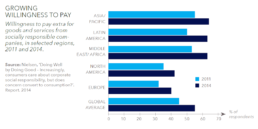Help us discover new solutions that help reach SDG 12 – ensuring sustainable consumption and production patterns.
Sustainia is on a quest to map out the newest market opportunities for a better tomorrow, and we’re calling on you to help us discover new solutions that are addressing the global goals in need of urgent attention if we are to deliver on their aims by 2030. Here, we dive into Sustainable Development Goal (SDG) 12: ensuring sustainable consumption and production patterns.
Human consumption of goods and services has grown exponentially over the decades, bringing negative impacts through primary resource extraction, processing pollution, and consumption waste. SDG 12 is a global goal that touches on nearly all aspects of how we live our lives, and with global supply chains now the norm, the distant impacts of our consumption habits are difficult to perceive.
The Global Footprint Network estimates the date when the global population exceeds the ecological resources and services that the earth can regenerate in a year. In 2017, it fell on the second of August. We are using resources at a rate that requires 1.7 planets, and if everyone lived like an average American, we would need five planets to sustain our consumption needs… Clearly our traditional linear process of make-use-throw, need to be examined.
In DNV GL’s Future of Spaceship Earth report, they suggest that all regions of the world bar one are high above the threshold of sustainable production and consumption levels. Decoupling economic growth from natural resource use is key here, and the UN estimate that from 2000-2010 there was a worrying increase in total material consumption as well as per unit of GDP. Forecasts suggest that by 2030, sustainable business practices and consumer habits will not be well ingrained enough to meet many of the targets of SDG 12.

Where are the opportunities?
There is a great untapped potential for solutions addressing sustainable consumption and production. Twenty of the markets here on the Global Opportunity Explorer have an aspect that addresses SDG 12. Businesses and governments are increasingly recognizing the need for our production and consumption chains to become more circular, and the division between waste and resources is starting to blur. It is estimated that if Europe adopted circular economy principles, they could generate a net economic benefit of €1.8 trillion, as well as significant environmental and social benefits. Why should soils be depleted of nutrients when there are more sustainable and more economical alternative methods? Why should the amount of plastic in our oceans outweigh the fish when it could instead be reused or recycled?
This is where we need you!
Do you know about a solution that is helping to improve production and/or consumption patterns? It could be a smart, low-impact farming technique that reduces the levels of water input needed, or a way of reimagining plastic waste. We need your help to identify solutions that are readily available, financially viable, scaleable, have the capacity to improve quality of life, and have a positive environmental impact. We aim to showcase the best submitted solutions online and feature them in an upcoming report to show business around the world that there are commercial opportunities in all SDGs – also in the ones currently lagging behind. What solution has just popped into you mind?

Learn more about Sustainia’s crowdsourcing campaign, which seeks to identify solutions addressing the four SDGs (SDG 10, 12, 13 and 14) we are least on track to reach by 2030.
You can also check out all the SDG 12 solutions we already feature on Global Opportunity Explorer.
Author: Jack Robinson

